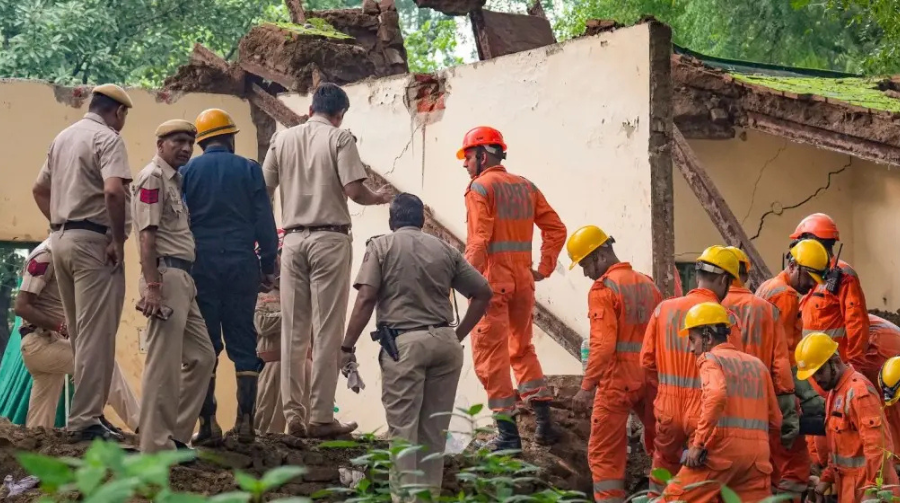News
Tragedy Near Humayun’s Tomb: Six Dead, Five Injured After Collapse at Dargah Complex
Delhi woke up to heartbreaking news when a portion of an old structure near Humayun’s Tomb collapsed, killing six people and injuring five others. The incident occurred in the Dargah Sharif Patte Shah complex, located behind the UNESCO World Heritage Site. While Humayun’s Tomb itself was not affected, the tragedy has raised urgent questions about the safety of aging structures around historic monuments.

The Site of the Incident
The accident site is not inside the main Humayun’s Tomb monument but at a dilapidated room within the nearby Dargah compound. The Dargah is often visited by locals and pilgrims, especially during religious occasions. Over the years, several portions of the structure had fallen into disrepair, with visible cracks and water damage.
How the Tragedy Unfolded
On the day of the incident, heavy rainfall had been reported across parts of Delhi. Several people had taken shelter inside the fragile structure. Suddenly, without warning, the roof and walls gave way, burying those inside under debris.
Eyewitnesses reported a loud crashing sound followed by cries for help. Locals rushed to the site before rescue teams arrived, using bare hands to pull people out from the rubble.
Rescue Operations: A Race Against Time
The National Disaster Response Force (NDRF), local police, and Delhi Fire Services responded quickly. Rescue efforts lasted for nearly three hours.
- Six bodies were pulled out from the debris.
- Five people were found alive but severely injured and were rushed to nearby hospitals.
Rescuers described the operation as extremely challenging due to the narrow lanes of Nizamuddin area and the unstable debris that posed additional risks.
Victims and Their Families
The victims were mostly local residents and workers. Some had gone to the Dargah to pray, while others sought shelter from the rain. Families of the deceased gathered outside the complex in grief, demanding accountability for the loss of lives.
One survivor recounted:
“We were just sitting inside to avoid the rain. Suddenly, the walls began to crack, and within seconds everything collapsed. People were screaming; we couldn’t move.”
What Triggered the Collapse?
Preliminary investigations point to structural weakness and neglect. The old room was never reinforced despite clear signs of decay. Continuous rainfall may have further weakened the foundation.
Experts suggest that many such unmonitored, heritage-adjacent buildings in Delhi pose similar risks. Without timely inspections and repairs, more such accidents could occur.
ASI’s Statement: Humayun’s Tomb Remains Safe
In response to rumors, the Archaeological Survey of India (ASI) clarified that Humayun’s Tomb is in perfect structural condition.
- The collapse occurred in a separate structure belonging to the Dargah complex, not within the protected monument area.
- ASI officials reassured the public that the World Heritage Site is regularly maintained and remains completely safe for visitors.
This clarification was important because Humayun’s Tomb is not only a historical monument but also a major tourist attraction, drawing visitors from across the world.
Local Reactions and Anger
The incident has sparked anger among locals, who allege that authorities ignored repeated warnings about the dangerous condition of the building. Residents claim:
- Cracks and leaks had been visible for years.
- Complaints were made, but no action was taken.
- The accident could have been avoided with timely restoration.
Civic bodies are now under pressure to carry out safety audits of all heritage-linked residential and religious complexes.
Importance of Heritage Safety in Delhi
Delhi is home to over 1,700 monuments and heritage sites. While major landmarks like the Red Fort, Qutub Minar, and Humayun’s Tomb are maintained by ASI, many smaller structures are neglected. These include mosques, dargahs, stepwells, and old havelis that still house communities.
Experts warn that unchecked urban development, pollution, and climate factors are accelerating the decay of these structures. Unless proactive measures are taken, tragedies like this will become more frequent.
Historical Significance of Humayun’s Tomb
Although the tragedy did not directly affect Humayun’s Tomb, its proximity makes it necessary to revisit its importance.
- Built in 1565, commissioned by Empress Bega Begum for Emperor Humayun.
- Designed by Persian architect Mirak Mirza Ghiyas.
- Considered the first garden-tomb in the Indian subcontinent.
- Inspired the design of later Mughal monuments, including the Taj Mahal.
- Declared a UNESCO World Heritage Site in 1993.
The tomb is not just an architectural marvel but also a symbol of India’s Mughal heritage. Incidents around it highlight the fragile balance between preserving history and ensuring safety.
Lessons from the Tragedy
The Humayun’s Tomb accident offers crucial lessons:
- Regular Inspections – All heritage-adjacent structures must undergo periodic safety checks.
- Community Awareness – Residents should be educated about risks in dilapidated buildings.
- Funding for Restoration – More government and private funding is required to maintain not just big monuments but also small, neglected ones.
- Emergency Preparedness – Faster disaster-response mechanisms in heritage zones.